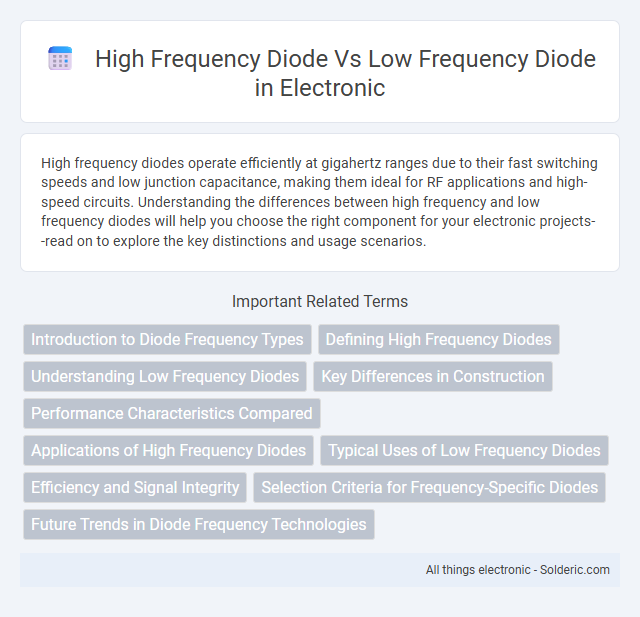High frequency diodes operate efficiently at gigahertz ranges due to their fast switching speeds and low junction capacitance, making them ideal for RF applications and high-speed circuits. Understanding the differences between high frequency and low frequency diodes will help you choose the right component for your electronic projects--read on to explore the key distinctions and usage scenarios.
Comparison Table
| Feature | High Frequency Diode | Low Frequency Diode |
|---|---|---|
| Signal Frequency | Typically above 1 MHz | Below 1 MHz |
| Switching Speed | Very fast (nanoseconds) | Slower (microseconds) |
| Application | RF circuits, high-speed switching | Power rectification, low-speed switching |
| Junction Capacitance | Low capacitance for minimal signal loss | Higher capacitance, suitable for power |
| Reverse Recovery Time | Short (ns to tens of ns) | Long (microseconds) |
| Material | Usually silicon, Schottky or PIN diodes | Silicon standard diodes |
| Power Rating | Lower power handling | Higher power handling capacity |
Introduction to Diode Frequency Types
High frequency diodes are designed to operate efficiently at frequencies above 1 MHz, making them ideal for RF applications, switching power supplies, and signal detection. Low frequency diodes typically function below 1 MHz, commonly used in rectification and power conversion where fast switching is less critical. Understanding your circuit's frequency requirements ensures selecting the right diode type enhances performance and reliability.
Defining High Frequency Diodes
High frequency diodes are semiconductor devices designed to operate efficiently at radio frequencies, typically above 100 MHz, making them ideal for applications like RF signal detection and microwave circuits. These diodes have low junction capacitance and fast switching speeds, enabling minimal signal distortion and improved performance in high-speed communication systems. Your choice between high frequency and low frequency diodes should consider operating frequency requirements and switching speed for optimal device functionality.
Understanding Low Frequency Diodes
Low frequency diodes operate efficiently at frequencies below 100 kHz, making them ideal for power rectification in AC to DC conversion and signal demodulation in audio equipment. Their slower switching speed results in higher forward voltage drops and increased power losses compared to high frequency diodes used in RF applications. Understanding low frequency diodes helps you select the right component for applications requiring robust, reliable performance in power electronics and industrial circuits.
Key Differences in Construction
High frequency diodes typically feature a smaller junction area with a thin, highly doped semiconductor region to enable rapid switching and minimal charge storage, whereas low frequency diodes have larger junctions designed to handle higher currents with slower switching speeds. The construction of high frequency diodes emphasizes minimal parasitic capacitance and inductance, often using materials like gallium arsenide or silicon carbide for improved performance at microwave frequencies. In contrast, low frequency diodes generally use silicon with thicker depletion regions, prioritizing durability and efficiency for rectification and power applications at frequencies below 1 MHz.
Performance Characteristics Compared
High frequency diodes exhibit fast switching speeds and low junction capacitance, making them ideal for RF applications and high-speed signal processing. Low frequency diodes, in contrast, handle higher current and voltage levels but have slower response times and higher capacitance, limiting their efficiency in rapid switching scenarios. Your choice depends on the frequency range and specific performance requirements of your electronic circuit.
Applications of High Frequency Diodes
High frequency diodes are essential in applications requiring rapid switching and signal processing, such as radio frequency (RF) circuits, microwave communication, and high-speed digital electronics. Their fast response times and low junction capacitance make them ideal for use in mixers, detectors, and oscillators within telecommunication devices and radar systems. Your choice of a high frequency diode ensures improved performance in these advanced electronic applications compared to low frequency diodes.
Typical Uses of Low Frequency Diodes
Low frequency diodes are primarily used in power rectification, signal demodulation, and voltage regulation applications within audio equipment, power supplies, and radio receivers. Their ability to handle higher current loads makes them suitable for converting alternating current (AC) to direct current (DC) in household electronics and industrial machinery. You can rely on low frequency diodes when efficiency in low-speed switching and high durability is required for stable device operation.
Efficiency and Signal Integrity
High frequency diodes typically offer superior efficiency due to their faster switching speeds and lower junction capacitance, which reduces power losses in RF applications. Low frequency diodes, while more robust, exhibit higher reverse recovery times that can degrade signal integrity and increase distortion in high-speed circuits. Choosing the right diode can significantly impact your system's performance by maintaining signal clarity and minimizing energy loss.
Selection Criteria for Frequency-Specific Diodes
High frequency diodes are chosen for applications requiring fast switching speeds and low junction capacitance, such as RF circuits and microwave systems, due to their ability to operate efficiently at GHz ranges. Low frequency diodes, with higher junction capacitance and slower switching speeds, are suited for power rectification and signal demodulation in audio and power supply circuits operating below MHz frequencies. Selection criteria focus on parameters like recovery time, capacitance, forward voltage drop, and intended operating frequency to ensure optimal diode performance in specific frequency ranges.
Future Trends in Diode Frequency Technologies
Emerging trends in diode frequency technologies emphasize advancements in high frequency diode materials such as gallium nitride (GaN) and silicon carbide (SiC), which offer superior performance for 5G and beyond communication systems. Low frequency diodes continue to be optimized for power efficiency and thermal management in renewable energy and electric vehicle applications, ensuring longer device lifespan and reliability. You can expect future diode innovations to increasingly integrate smart functionalities and enhanced switching speeds, bridging the gap between conventional low frequency and ultra-high frequency uses.
High frequency diode vs Low frequency diode Infographic

 solderic.com
solderic.com